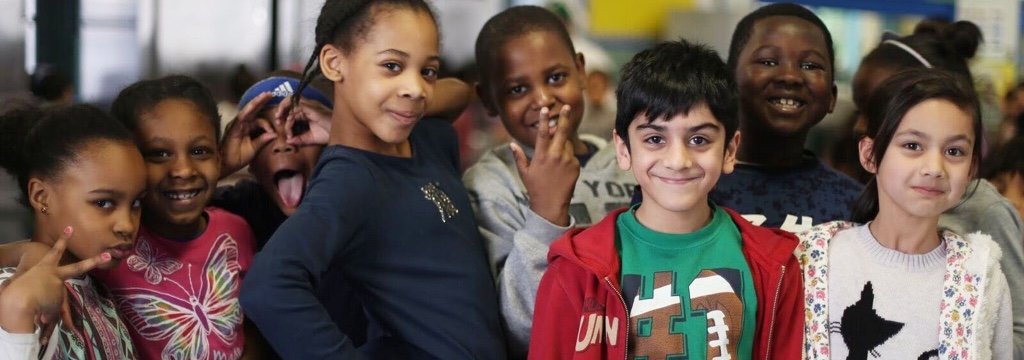Get more from InsideSchools
P.S. 183 Robert L. Stevenson
Share this school
Manhattan NY 10065
Our Insights
What’s Special
Strong, creative work in all grades; proximity to world-class research institutions enriches the school
The Downside
Large class sizes in the upper grades
PS 183 is a vibrant neighborhood school with involved parents, committed staff and rich, engaging academics. Its also a multicultural place: Some neighborhood families come from abroad to work as scientists and healthcare professionals at Rockefeller University and the several world-class hospitals in the area. Among the student body, nearly 40 different languages are spoken.
The vibe throughout the school is welcoming and creative, which is apparent as soon as one enters the century-old building. Photos of smiling staff and a display celebrating the languages spoken at the school flank the main office entrance. The narrow hallways are lined with student artwork and projects. Classrooms are lively spaces where students move around with purpose. Its common to walk into a room and find children sprawled out on the rug or couch, reading and writing, while others work at tables or in a cozy corner of the room. Class sizes run large in the upper gradesroughly 32 in the 5th-gradebut class routines are well established so kids move smoothly from one activity to the next with little time wasted.
"We want students to take ownership of their learning," said Tara Napoleoni, the school's principal since 2010. [Martin Woodard replaced Naopoleoni in 2017. She left to take a job as principal of an elementary school in Rye Neck, NY.] Teachers are very adept at meeting childrens individual needs. In the younger grades students keep folders with personalized teacher notes such as what level books they should be reading, which areas they're strong in, which skills they need to practice more, and suggestions for challenge work.
The school uses the Teachers College Reading and Writing Project curriculum, which encourages students to read a wide array of books of their choosing and at their skill level as well as write and revise multiple drafts of work on a variety of topics. They read serial stories, mysteries and historical fiction as well as biographies, memoirs, and books on social issues and science. Teachers also connect readings to topics studied in other subjects. For instance, 4th-graders learn about soil erosion in science at the same time they are reading and writing about floods and environmental themes in class. Fifth-graders read historical fiction such as Across the Wide and Lonesome Prairie when learning about westward expansion in social studies.
Typical of many District 2 schools, 183 uses Investigations Math, 3rd edition, which emphasizes conceptual learning and multiple approaches to problem solving. Teachers balance this with some drilling of math facts. A part-time math coach works with teachers to develop lessons and visits classrooms to help with instruction.
In fifth grade, classes are departmentalizedessentially a modified middle school format. Each 5th-grade teacher specializes in one of three areasreading, writing or mathand students travel with their class to different rooms for instruction in those subjects. The benefit is that students are taught by a specialist in a classroom filled with resources to support that subject. Students spend roughly two periods a day in their homeroom class where they learn social studies and science (in addition to their twice-weekly visits to the science room) and get extra instruction in reading, writing and math too.
Every Friday, students in all grades participate in small-group electives. Teachers, staff, the principal and even parents volunteer to run one of over 40 clubs that cover a range of interests such as story telling, singing, knitting, cooking and STEM (science, technology, engineering and math). Students get to try a new club every five weeks.
Parent involvement is strong. In addition to raising money for teaching assistants and to support school programs, parents volunteer in a variety of ways: grant writing, leading school tours, running events such as the school carnival, helping out in art and music classes, and much more.
Outside organizations such as Wingspan Arts, ChessNYC, Yorkville Sports and Drama Kids run a range of onsite activities after school.
SPECIAL EDUCATION: In addition to SETSS there is an ICT class on each grade.
ADMISSIONS: Zoned, neighborhood school. (Laura Zingmond, December 2015; updated by phone August 2016; principal update only 2019)
Read moreSchool Stats
Is this school safe and well-run?
From the 2024-2025 NYC School Survey
From this school's most recent Quality Review Report
From the 2023-24 School Quality Report
How do students perform academically?
From the New York State 2023-2024 Assessment Database
What is the Pre-K like?
From the NYC Program Assessment (CLASS and ECERS-R) Database through 2019-2020
Who does this school serve?
From the 2024-25 Demographic Snapshot
From the 2023-24 School Quality Guide
From the 2020 School Directories
How does this school serve special populations?
From the New York State 2023-2024 Assessment Database
Contact & Location
Location
Contact
Other Details
Zone for the 2019-2020 school year. Call school to confirm.
Was this information helpful?
Get more from InsideSchools
You may also like …
East Side Elementary School, PS 267
Manhattan, NY 10065

Comments